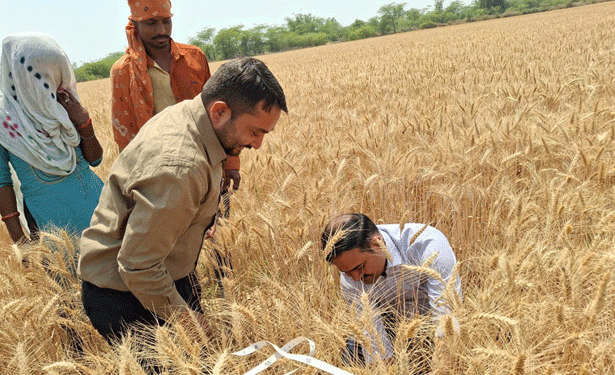Understanding Wheat Yields in Gauriganj: A Field-Level Evaluation of Productivity and Farmer Welfare
On a recent visit to Saitha village, Gauriganj (Uttar Pradesh), Additional District Magistrate (Finance & Revenue) Arpit Gupta led a crop cutting experiment to assess actual wheat production in local fields. This initiative, carried out with support from the Revenue and Agriculture Departments, plays a vital role in determining insurance compensations under the Pradhan Mantri Fasal Bima Yojana (PMFBY).
Field Data: Real Yields from the Ground
The crop cutting was performed on plots measuring 43.03 square meters in the fields of four farmers: Kaushalya, Rajbula, Sanjay Kumar, and Jagdish Singh. The harvested wheat weights were as follows:
- Kaushalya: 15.54 kg
- Rajbula: 16.97 kg
- Sanjay Kumar: 14.85 kg
- Jagdish Singh: 15.05 kg
These weights translate to yields of approximately 36.2 to 39.5 quintals per hectare, aligning closely with the average wheat productivity in Uttar Pradesh, which stood at around 38 quintals/ha in 2023–24, according to the Ministry of Agriculture and Farmers Welfare.
Such micro-level data is essential for calculating accurate indemnities for crop loss and for improving regional agricultural planning.
Encouraging Government Procurement and Fair Pricing
During his visit, ADM Arpit Gupta also urged farmers to sell their wheat at nearby government procurement centers, emphasizing that this ensures Minimum Support Price (MSP) protection, transparency, and direct bank transfers. For the 2024–25 season, the MSP for wheat in India is ₹2,275 per quintal, a slight increase aimed at supporting farm incomes.
By selling to official centers rather than private agents or middlemen, farmers can avoid price exploitation and ensure that their production efforts are properly rewarded.
Promoting Sustainable Practices: No Stubble Burning
The ADM also made an important appeal to avoid burning crop residues, a common but environmentally harmful practice. Stubble burning contributes to:
- Air pollution
- Soil degradation
- Loss of soil microbial health
Alternatives such as mulching, composting, or using stubble for biofuel or fodder are now being promoted by the government through subsidy-supported machinery like the Happy Seeder and Super Straw Management System (SMS).
The crop cutting experiment in Gauriganj offers valuable insight into wheat productivity, farmer compensation, and sustainability efforts. Such initiatives not only ensure data-driven agricultural policy, but also strengthen the connection between farmers and institutional support systems. With proper yield estimation, fair procurement practices, and a shift toward eco-friendly residue management, farmers can expect better returns and a more resilient future.
Error





